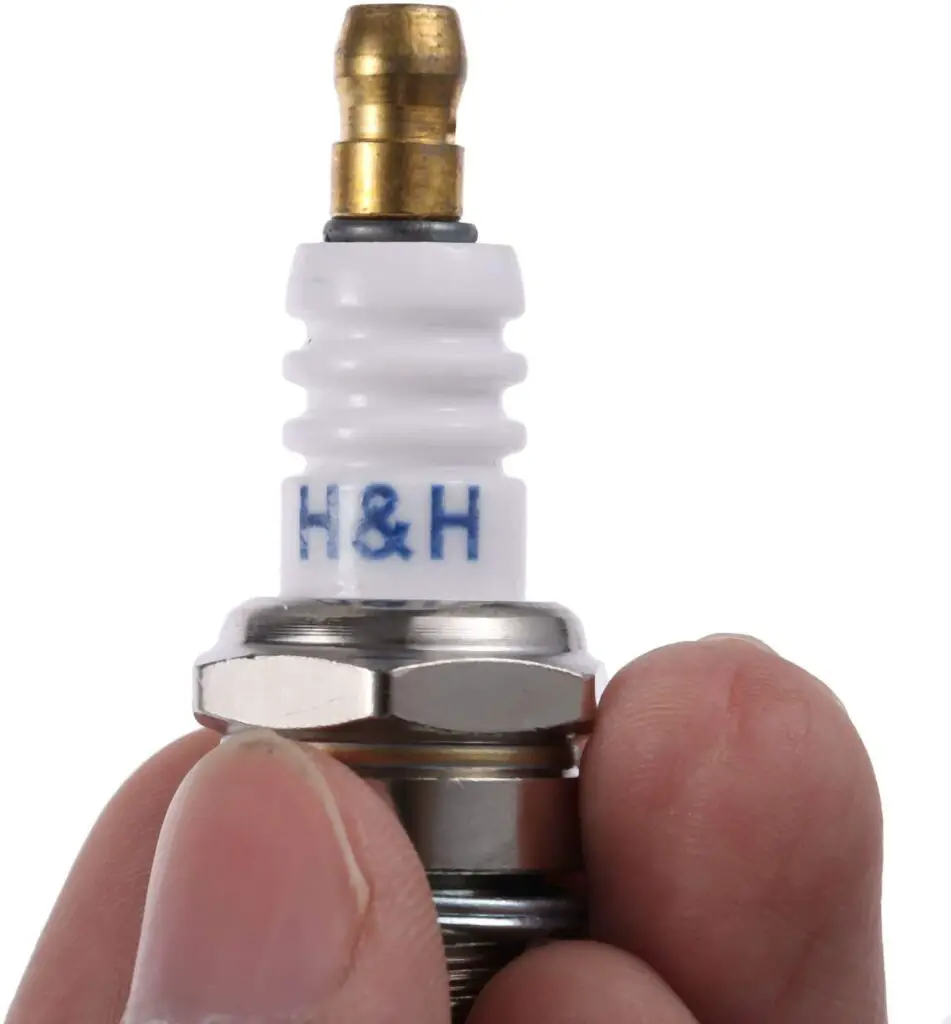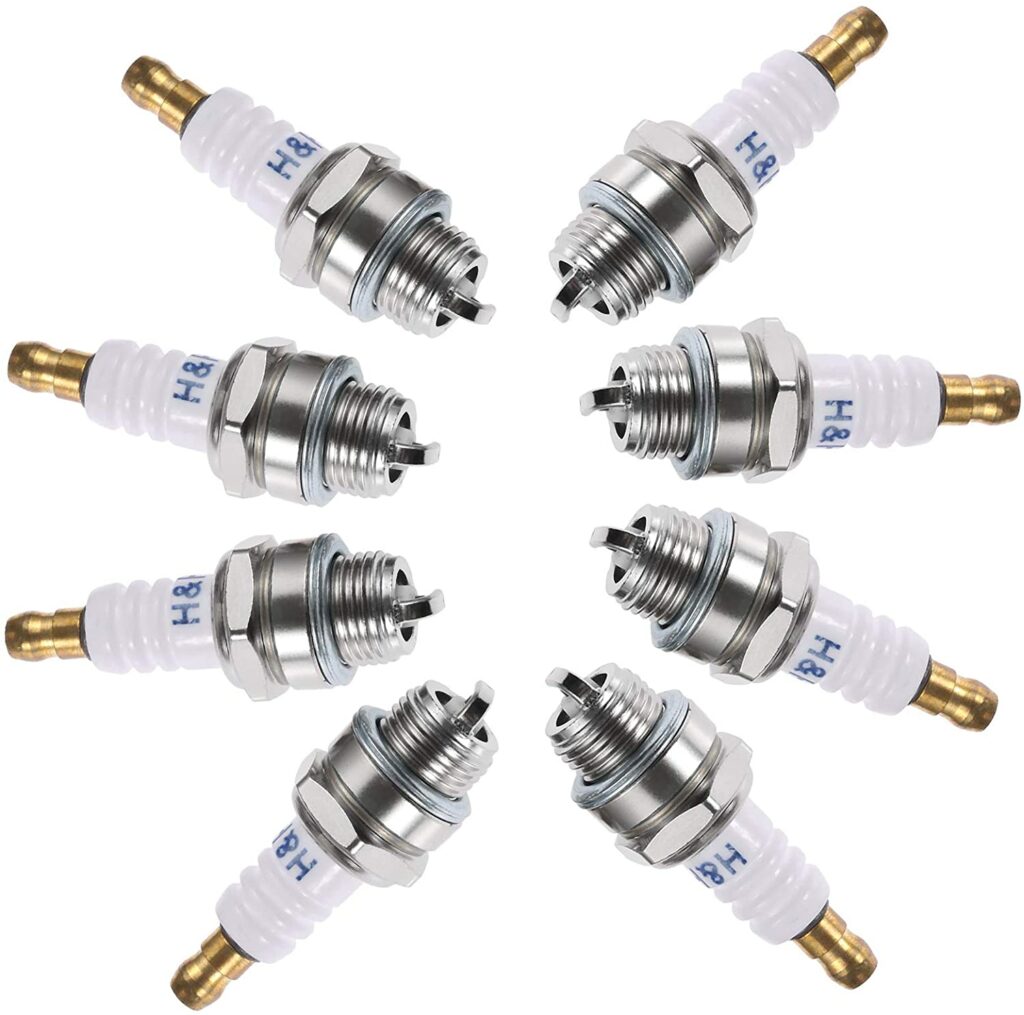Have you ever headed outside to start your lawn mower during mowing season just to suddenly watch it struggle or to not start at all? If so, the issue might be your lawn mower spark plug.
When your spark plug is bad, you’ll notice a whole host of problems with the way your lawn mower starts and operates, and that’s a sure sign that you need to replace it.
Whilst today I won’t be covering how to actually replace spark plugs on your lawn mower in great depth, I will discuss how to tell if your mower spark plugs need replacing or not. That way, you can stop stressing about your lawn mower’s problems (or worse, throw it out when you don’t need to).
But What Exactly Does A Spark Plug Do?
The reason I’m asking and answering that question is that it’s much easier to understand if you have a bad spark plug when you know what the thing does to begin with.
So, lawn mower spark plugs: what do they do?
A spark plug is only present in a gasoline powered lawnmower, and it’s a spark plug’s job to set an ignition spark that allows the lawn mower’s engine to run.
Spark plugs are actually an electrical device in an otherwise highly mechanical engine, with a central electrode that receives a high voltage from an ignition coil. This voltage creates a high potential difference between the center electrode (which receives the voltage) and the ground electrode (which does not). It then creates a spark of current, which flows between the two electrodes.
The spark that’s created will ignite a fuel and air mixture in the engine cylinder head. The continued burning of the fuel-air mix in the engine’s combustion chamber allows the engine to run.
Essentially, a spark plug is critical for this type of gasoline powered outdoor power equipment, because without it, the engine couldn’t start.

How Does A Spark Plug Affect Performance?
When functioning correctly, a lawnmower’s spark plug will allow the engine to start quickly, without resistance, and will keep the engine running smoothly the entire time. If your mower is in good shape, then you’ll notice that it runs without any juttering or stuttering.
You should also notice good fuel efficiency. Since the spark plug is responsible for almost everything that happens in the combustion chamber, if it’s working properly, you’ll get more bang for your buck in terms of how far the fuel stretches.
But that’s what should be happening – what about when things go wrong in lawn mowers’ small engines?
So, What Problems Should You Look Out For?
Although small, engine spark plugs play a crucial role in almost every aspect of a lawn mower engine. So there are a few areas of how your mower works and starts that you need to pay special attention to:
- If the engine starts (and how)
- Problems whilst running your push mower or riding mower
- Fuel consumption
Signs Of A Bad Spark Plug
Starting
You can usually tell if your spark plug is bad by the way your mower starts. With a push lawn mower, you’ll notice that it takes more pulls on the starter rope than usual, and with a ride-on mower, it’ll take a few more turns of the key.
But that’s if you even get it to start. Sometimes a bad spark plug won’t allow the engine to start at all.
Running
If it starts fine, bad spark plugs could still affect the way the mower runs. If you notice engine sputtering, then this is usually a good way of knowing that you will need to change the spark plug soon.
A sputtering engine is a clear indication that the spark plug is on its last legs and is only just managing to keep the engine running.
Fuel
Excessive fuel consumption is another way to tell if the spark plug isn’t working as it should. Think about it, it’s a spark plug’s job to keep the fuel burning, so if it isn’t working correctly, then it will need to use more fuel to keep the engine performing. In fact, the engine will flood as the air-fuel mixture enters the cylinder, causing more of it to be wasted since it isn’t burning in the way that it should.
A small engine like that of a lawnmower shouldn’t use excess fuel, and you certainly shouldn’t notice your fuel tank empty after just one bout of lawn care. If you’re topping up with fresh fuel more regularly than before, then the chances are your spark plugs need changing. You might also notice the smell of raw gasoline, too, which shows that it’s flooding the small engine and being wasted.
How Should A Lawn Mower Spark Plug Look?
We’ve covered how a lawn mower spark plug should make the mower feel, but we haven’t covered what the spark plugs themselves should actually look like.
If you’ve noticed problems with your lawnmower’s performance relating to starting, running, and/or fuel, then the chances are you will need to replace the spark plug. But in order to know for sure that the spark plug is the problem, you’ll need to lift the engine cover and check it out for yourself.
THINGS YOU’LL NEED
- Spark plug socket
- Soft wire brush
Getting To The Spark Plugs
The spark plug socket is a tool specifically designed for your spark plug. Start by removing the spark plug lead, and then use the tool to unscrew the spark plug. This will allow you to inspect it properly to make sure everything is working as it should.
Remember, the spark plug is easy to find. Just look for a device with a central electrode covered in a protective porcelain sheath, an arch of metal between it and the side electrode, and a threaded shank connected to the engine block.
You’ll need to lift the protective sheath to get to the spark plug wires to disconnect it for a closer look.
Problems You May See
One common problem you might notice is a crack or damage to the spark plug’s porcelain sheath. If this happens, then the central electrode can’t be protected or work right, so you’ll need to replace the entire spark plug.
The live or central electrode should also be completely flat and even. If it’s damaged, curved, or uneven in any way, then again, you will need to remove the spark plug and put in a new plug. When a spark plug becomes overly worn, it can’t work the way it used to.
Problems That Don’t Necessarily Call For New Spark Plugs
You should also check the spark plug gap whilst you’re here. Without the proper gap, a spark plug can’t operate effectively. The correct spark plug gap for your lawn mower should be given in the manufacturer’s specifications or owner’s manual. Adjust it according to the instructions, and you might not need to replace the spark plugs at all.
Another common problem that doesn’t call for a new plug is carbon buildup. This happens naturally over time, but only calls for some spark plug maintenance; not changing spark plugs. Here is where you’ll need to take your soft wire brush to clean it up. If, after the buildup is gone, everything seems normal, try to start your engine again when everything is safely back in place. You might not need new spark plugs at all – just a cleanup of the old plug!
A NOTE ON OIL FOULING
Oil fouling is very similar to carbon buildup, but will need a replacement plug. Cleaning it up won’t be a simple fix here, as this problem is caused by a worn spark plug, so you’ll need to replace it. You’ll notice the difference between the two, though, by the oil on the tip of the plug. You’ll also notice oil in the combustion chamber, too.
If in doubt, it’s best to try cleaning up the issue, anyway. If the problem is a buildup of carbon, then the issue will be fixed. But if it’s an oil issue, the worn spark plug will still not work as it should.

Next Steps
If you notice problems with the way your mower starts, runs, and uses fuel, then it’s time for a new spark plug. To be doubly sure, though, get into the engine and have a look for worn, damaged, or oil fouled parts.
After you’ve removed the spark plug lead and investigated, you’ll know more about the exact problem and whether or not the plug needs to be replaced.
I won’t cover how to replace a spark plug just yet, but with a spark plug socket and a new plug, replacing it is simple. And thanks to your investigation, you’re already halfway there!
But for now, I hope I’ve helped you understand if your spark plug needs replacing or cleaning, so you can move on to replacing it only if you really need to!


